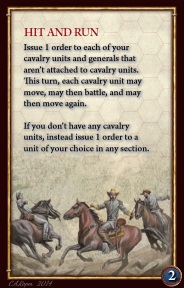{phocadocumentation view=navigation|type=mpcn}
|
|
|
|
|
HIT AND RUN Issue 1 order to each of your |
||
|
|
Related FAQs
May orders be issued to Generals that are already attached to infantry and/or artillery units?
Yes. The card reads "and generals that aren't attached to cavalry" may be ordered.
Are the units they are attached to ordered as well?
No.
May an ordered General detach from its unit and make a normal move to attach to a friendly cavalry unit?
Yes.
May a Cavalry unit ordered under the Hit and Run card still take their second move with a General that attached to it during the first move and after all battles are completed?
Generals that are not attached to a cavalry unit may only make one move (up to 3 hexes) when ordered. Moving and attaching a general to a cavalry unit will prevent the cavalry unit from moving again. Another words Generals attached to a cavalry unit may move with the cavalry unit, battle, and make a second move with the cavalry unit. While a General not attached to a cavalry unit may only make one move.
May a general ordered under play of the Hit and Run card delay in executing its order to move until the second cavalry movement segment?
No. All General movement is done along with the first move of the cavalry.
Must you have cavalry on the board at the time you play a Hit and Run card to order any generals through the use of the card?
If you do not have any cavalry units, you have a choice to order Generals or order one unit of your choice.
Q: Does the Hit and Run card allow a cavalry unit to enter a woods or river hex on the first move then exit (possibly entering a second woods or river hex) on its second move?
Yes. The intent of this Hit and Run card, is to give the cavalry unit two movements on the same card play. Another way to state this is to say a cavalry unit is making two movements on this card play.
Normal cavalry movement is up to three hexes. When cavalry enters a terrain hex that halts movement, its movement is stopped.
What the Hit and Run card lets you do is to make a second move on the same turn. The cavalry may not battle twice on the turn; it may only battle after its first movement. Of course, it does not need to make a move and may target an enemy in an adjacent hex. After its battle it may make a move. Terrain effects will apply to both moves, i.e., if the cavalry moved into a woods hex on its first move, it could move no further and would not be able to battle either. It may make a second move out of the woods.
One other note about the 'Hit and Run' card. You do not need to run back after an attack. The card's name may imply this but the cavalry may move forward, back or to its flank. Also for the record, a cavalry unit doesn't have to battle at the end of its first move, to get its second move.
Play of a Hit and Run card, and a general is already is attached to a cavalry unit that moves and attacks. A subsequent play and resolution of Fight Back card eliminates the cavalry unit, leaving the general alone. Could the now-unattached general still make a second move under the Hit and Run card?
No. He must remain in the hex because, if a cavalry unit forced to retreat or is eliminated it may not make a second move. (BC:150p.16). But if any flags were rolled, the lone general could make a retreat move of 1 hex per flag rolled due to the rules covering generals under Retreat: "An attached general must retreat with its unit to the same hex. If the unit is eliminated in battle, the general must make any retreat moves required."

